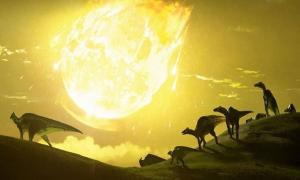The meteorite that caused the dinosaurs to go extinct crashed to Earth 66 million years ago at the steepest angle, releasing the maximum amount of gas causing climate change.
The research community agrees that the 200km-wide Chicxulub crater in present-day Mexico was formed when a giant meteorite crashed, killing three-quarters of life on Earth. But the trajectory and direction of the meteorite are still the subject of controversy. In the study, published May 26 in the journal Nature Communication, the international team said their 3D simulation showed the meteorite fell to the ground at an angle of 40-60 degrees. Lead researcher Gareth Collins, professor of planetary science in Imperial College London’s Department of Earth Sciences and Engineering, described this as the worst-case scenario for the dinosaurs.

The giant meteorite created the Chicxuclub crater 200km wide. (Photo: Fox).
“The asteroid impact released huge amounts of climate-changing gas into the atmosphere, accelerating the chain of events that led to the extinction of the dinosaurs. This process was certainly made worse by the meteorite crash in deadliest corner,” Collins said. “We know this is the worst-case scenario because it causes more toxic debris to hit the upper atmosphere and disperse it everywhere, leading to atomic winter.”
The collision created billions of tons of sulfur and other gases in the atmosphere, obscuring the Sun, causing the Earth’s temperature to drop sharply. The team from Imperial College London, UK, the University of Freiburg, Germany and the University of Texas, USA, examined the shape and structure of the impact crater as well as soil samples taken from it. “Despite being buried under nearly a kilometer of sedimentary rock, the geophysical data reveal a lot about the crater’s structure, reflecting the direction and angle of impact,” said Auriol Rae, a postdoctoral researcher at the University of Freiburg, study co-author, said.
This information and other data are used to build a simulation model of Chicxulub crater formation, helping researchers determine the direction and angle of flight of the meteorite. They consider 4 different angles 90, 60, 45 and 30 degrees. The research team thinks that the 60-degree angle is the most likely based on the relationship between the three locations: the center of the hole, the rim of the hole and the center of the mantle rock that is pushed up at a depth of 30 km below the hole.
At the Chicxulub crater, these positions are arranged in the southwest – northeast direction and 3D simulation at an angle of 60 degrees gives nearly identical results to the observed data. According to the team, this angle of impact produces more climate-changing gases such as sulfur and carbon dioxide than a shallow or near-vertical collision.

